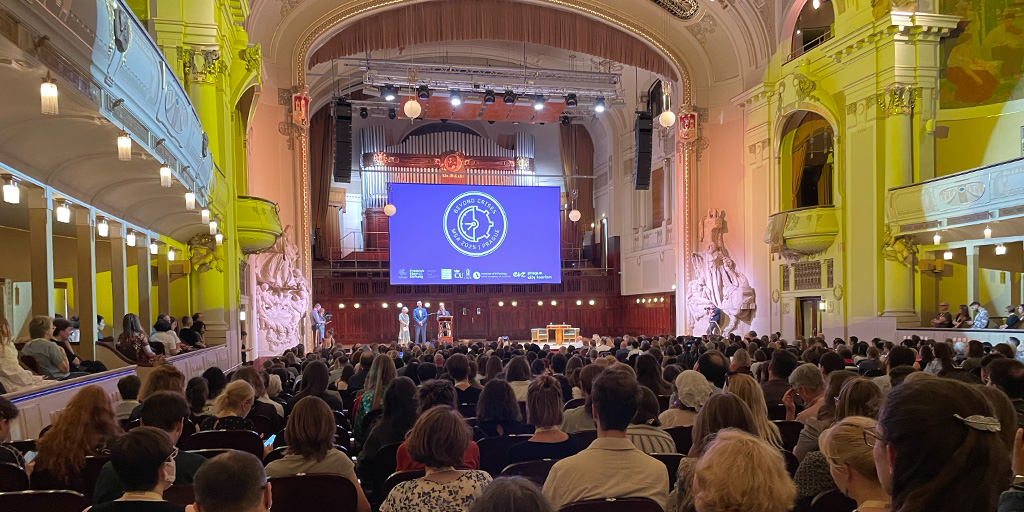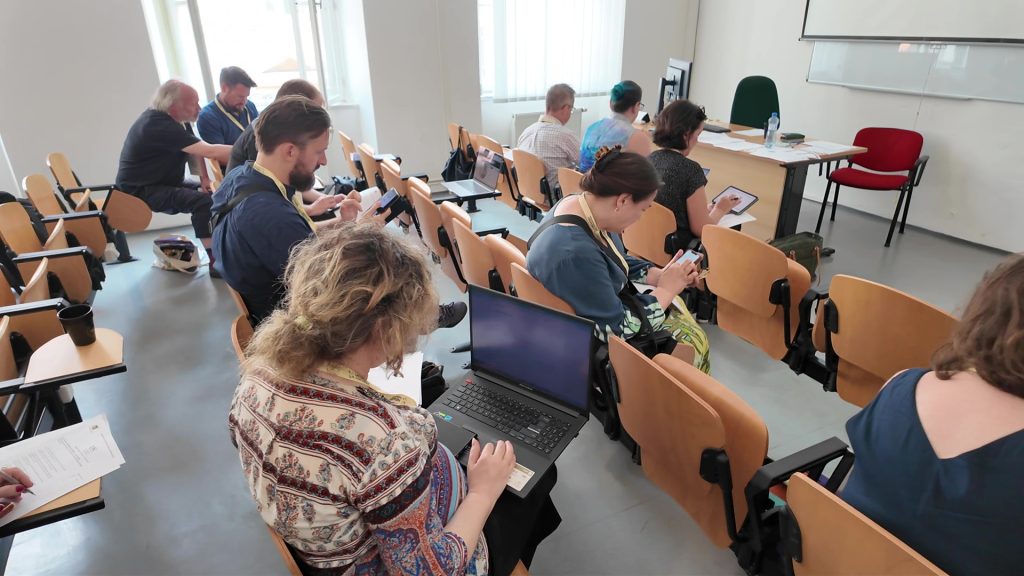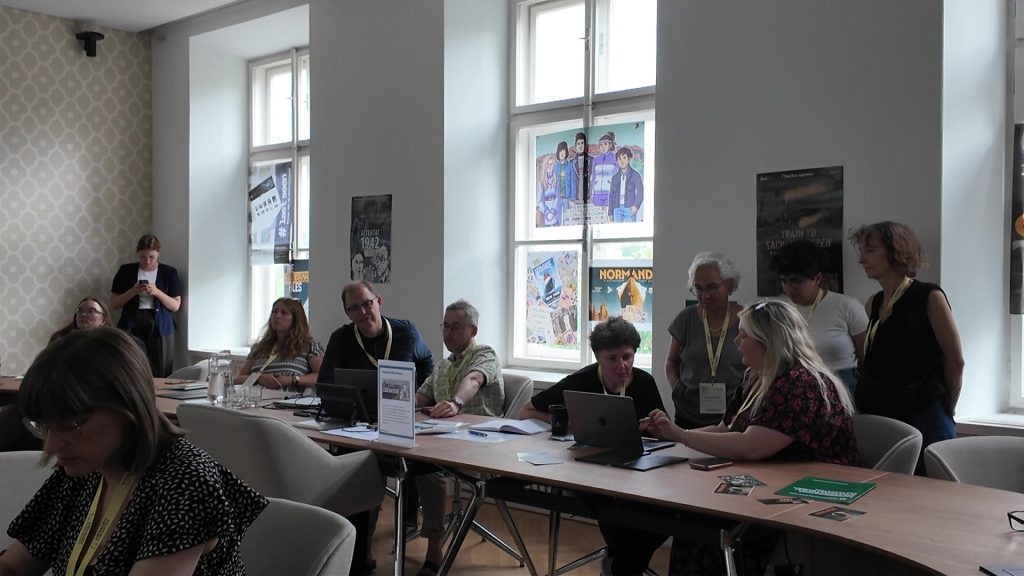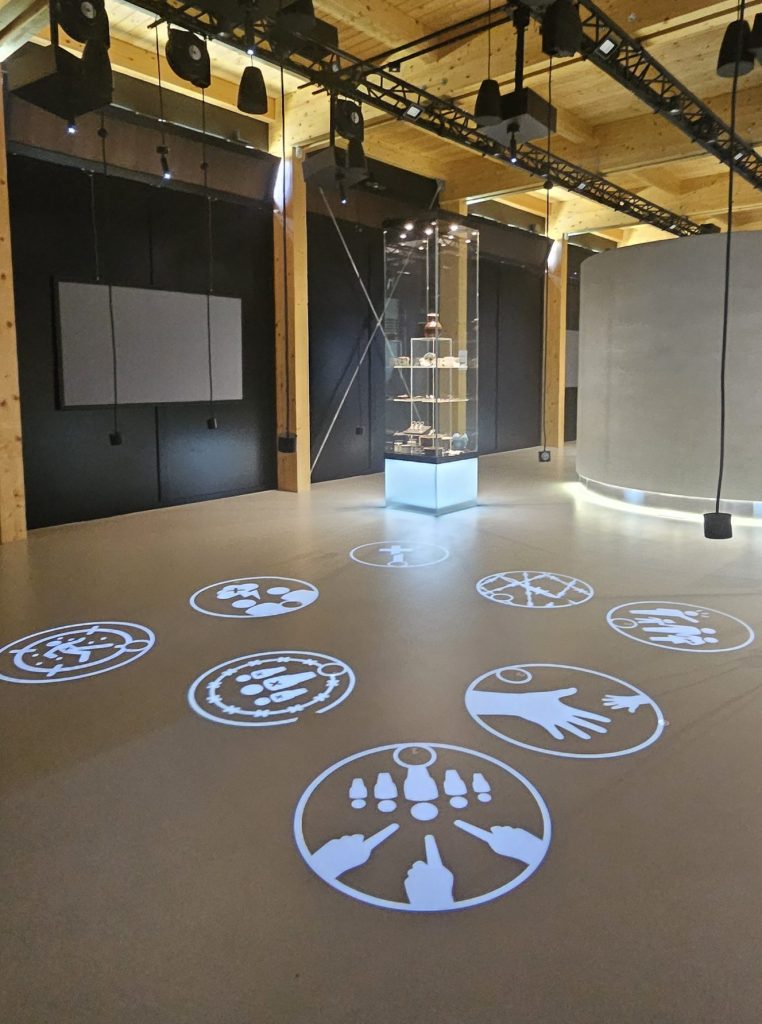
Reflections from the Memory Studies Association Conference, Prague
The research team of the Landecker Digital Memory Lab recently attended the Memory Studies Association’s annual conference, the world-leading event in the field, this year held across Charles University and the Czech Academy of Sciences in Prague, Czechia. During the packed, five-day programme, the Lab contributed to five sessions and joined many others. Find out what we shared and learned from three distinct perspectives.
By Dr. Ben Pelling, Dr. Kate Marrison and Prof. Victoria Grace Richardson-Walden
Dr. Ben Pelling, Research Fellow, Landecker Digital Memory Lab: As someone new to memory studies, the size of MSA Prague was at first quite overwhelming, with more than 1,400 participants. However, this does mean that there are plenty of panel sessions, workshops, tours and other events to suit all areas of scholarship or mere curiosity.
There was ample opportunity to sample sessions on topics diverse from one’s own research focus – a great way to learn about new methods and approaches that can be adopted and co-opted as needed or just enjoy the work of scholars studying a completely different topic.
One thing I learned during the event was that memory scholars are starting to engage with online, digital and mapping resources in their research. However, there are still many opportunities for bringing the tools and methodologies of Digital Humanities to bear on the rich and diverse subjects covered by memory studies scholars.
During the Museums and Memory session in which we invited delegates to user test our developing Digital Memory Database we welcomed them to join us for a hands-on exploration of the platform, which seeks to collect historical and contemporary digital Holocaust memory practice. Their feedback has directly informed the current phase of its development (read our blog by Lab software engineer James Alvarez for more on this)

Database test session. Credit: Dr. Ben Pelling.
Our workshop was very well received. Participants spent a good amount of time exploring the beta version of the database and gave us feedback both in writing and though detailed in-person discussion. Thanks to all who took part!
Dr Kate Marrison, Research Fellow, Landecker Digital Memory Lab: I ran a workshop on Holocaust-related computer games called Playing with Memory in Prague: Holocaust Computer Games in which we invited attendees to play games, bringing something of the spirit of our Connective Holocaust Commemoration Expo arcade to MSA Prague!
The workshop started with a quiz and a brief presentation which introduced the Lab’s core work on games to date (see for example the first in our Digital Memory Dialogues series on games and our recommendation report on gaming) before focusing on the Prague-based indie studio, Charles Games as a case study.
Charles Games is a spin out of Charles University and is closely associated with the Faculty of Social Sciences, so our workshop was taking place in the perfect location.

Dr. Kate Marrison’s session. Credit: Dr. Ben Pelling.
Showcasing three games set within the context of the Nazi occupation of Czechoslovakia and its aftermath, Attentat 1942 (2017), Svoboda: Liberation (2021) and Train to Sachsenhausen (2022), participants were encouraged to reflect on memory discourse at the local, national and regional level and more widely, the possibilities for digital innovation through games.
The session focused primarily on Attentat 1942, with the game projected onto large screens around the room, and it was interesting to watch a group of players emerged, making decisions collectively. It was also fantastic to see the MSA volunteers (students at Charles University) take an active interest in the session, adding huge value to the team where historical knowledge was key to the mission. The workshop closed with an open discussion which raised some important questions around the use of language, the role of archival materials, and the possibility of games for education.
On the final day, I chaired the panel Beyond the Witness? Creative Responses to Holocaust Materialities, comprised of presentations from Ingeborg Hjorth and Nina Skogli (The Falstad Centre), Lukas Meissel (The Hebrew University of Jerusalem), Jay Prosser (The University of Leeds) and Hannah Wilson (University of Manchester) demonstrating how creative responses to material objects can lead to powerful and affective encounters with memories.
These contributions form part of a forthcoming special issue of Holocaust Studies: A Journal of Culture and History addressing how objects have been mobilised in public, private and academic spheres, and in museums, monuments and archives. Marking an important shift in scholarship, this is the first time the journal has included creative contributions in the form of poetry, creative writing, artworks and critical reflections from practitioners.
I also attended some fantastic sessions, including the Witnessing Working Group meeting, which comprised a small but interdisciplinary group of scholars working with the notion of ‘witnessing’ across different contexts from the UK, Romania, Israel, Ukraine, Japan and Estonia. Among topics we discussed were plans to host workshops and new ideas for publications which would draw on expertise across MSA and continue to nurture relationships with other MSA working groups.
I was fortunate to attend the session, Memory’s Alive, the Story Continues! organized by Czech-German Fund for the Future which showcased four projects they have supported including ROMEA – The Roma Holocaust in virtual reality, an educational outreach project associated with the memorial of the concentration camp at Lety u Písku.
During our visit to the Jewish Museum in Prague – a museum of Jewish heritage – we discovered a digital display enabling visitors to search the ‘Shoah Victims Database’ which contains the names and fates of approximately 80,000 people who were deported from the territory of today’s Czech Republic and other European countries during WWII, including the men, women and children in Lety u Písku during 1942 and 1943. The display enables visitors to identify the exact location of the victim’s name as it is inscribed on the walls of the Pinkas Synagogue.
I also enjoyed the legendary MSA book raffle held at the Museum of Literature, led by Wulf Kansteiner and Jeffrey K. Olick in which MSA participants donate copies of a recent or favourite book, authored or edited by themselves or others in any language, also known as ‘Glastonbury for academics’.
As a team, we also found time to visit the memorial site and museums at Lidice and Lety. Lidice, a small village in Central Bohemia was destroyed in 1942 in response to the assassination of Reinhard Heydrich. This is the context for the game Attentat 1942 (the focus game of my workshop) which explores the aftermath of the assassination through the eyes of the protagonist, who is investigating the circumstances surrounding their grandfather’s arrest by the Gestapo.

Image: interactive exhibit at Lety u Pisku memorial, Czechia.
Credit: Prof. Victoria Grace Richardson-Walden.
Prof. Victoria Grace Richardson-Walden: As is becoming tradition, the MSA conference opened with working group meetings. It was great to see the Museums and Memory group which I co-founded in 2019 now has more than 300 members from across the world. It was well represented across the conference programme with 8 panels (of which I managed to attend 7!).
We started with a roundtable on museums and contemporary memory politics in precarious times, in which topics ranged from the precarity of work in UK museums to the vulnerability of museums in the US since January 2025, through questions of restitution, and more, with my contribution asking how could/should Holocaust museums engage with the Israel/Gaza conflict particularly given the increasingly instrumentalising of this past.
Other panels in this stream including two visitor studies sessions – one focused specifically on new technologies, another on temporality and colonial racial violence in museums (which sparked discussions about a future collaboration focused on ‘truth’ and museums), another on museums and memory amidst democratic crises built further upon some of the positions given at the working group’s opening roundtable.
Yet another session, which I had the honour to chair, was a powerful and thought-provoking exploration of comparative and contested memories of genocides and atrocities in museums, exploring the ‘Holocaust template‘ in Bosnia and Rwanda, the presentation of the Shanghai Ghetto in both China and Vienna, a comparison of new Holocaust exhibitions in London and Amsterdam, and decolonising practices in Indian museums.
The first keynote by Astrid Erll returned to Maurice Halbwachs’s formative work: ‘frameworks of social memory’, to explore how we can understand the ‘polycrisis’ facing memory, calling us all to be ‘reflexive’ in how we adopt historical approaches when exploring a memoryscape shaped by transcultural communication, digitality, and ecological crisis. It was presented in the grand 14th Century Karolinum of Charles University.
I contributed to two roundtables engaging with AI. The first ‘New Directions and Challenges in Memory Studies: Environmental Crises and the Rise of AI’, brought together two themes of early additions of the new journal Memory Studies Review, in which myself, Rik Smit (University of Groningen) and Clara De Massol (Kings College, London) shared a rather bleak view of the entanglement of AI and environmental issues.
The other, ‘Handling the Hype: Demystifying AI for Memory Studies’ was the first in-person meeting of (some of the) co-authors of a forthcoming commentary article of this name. Together with Rik Smit, Mykola Makhortykh, and Silvana Mandolessi (Ku Leuven), we introduced a range of critiques to help memory studies scholars engage with AI as a research subject, from environmental and geo-political foci to historical, technical, ecological, praxis, and ethics. We then opened discussion and asked delegates interested in developing a volume about studying AI in memory studies to stay in touch. Watch this space. (An acknowledgement must be given to our other co-authors, Qi Wang (Cornell) and Sam Merrill (Umeå University), the latter of whom initiated and has led this collaboration.)
I had the honour of chairing three awe-inspiring panels (the final one mentioned above in the Museums and Memory working group, as well as ‘Approaches to Commemorating Atrocities’ – in which two outstanding emerging scholars Rimanté Jaugaité (University of Warsaw) and Ann-Kathrin McLean (Royal Roads University) shared methodologies for studying memorials and museums. Particularly impressive was Jaugaite’s development of Ann Rigney’s ‘memory-activism-nexus’ to enfold art, to make the ‘memory-art-activism nexus’.
The panel ‘Algorithmic Shaping of Memory and Identity’ has also stayed with me. Dariusz Brzeziński (Polish Academy of Sciences) gave a paper on algorithmic nostalgic which has made me reconsider the core argument of my forthcoming monograph, whilst Merin Simi Raj and Avishek Parul from IIT Madras (India) presented a fantastic and energetically dense paper on digi-corporality and rewiring our relationship with machines for good, introducing some of their digital decolonial memory projects. We’re looking forward to being in contact further.
For me, the programme ended with the panel ‘Rethinking Holocaust Memory in and beyond the Crisis’, which confronted the field and its practitioners with difficult questions and ideas, but I didn’t think it fully recognised the scope of the current entangled crises that are creating tensions for those situated in Holocaust Studies and/or researching Holocaust memory. For me, it left more unresolved than faced. You can read more on my reflection on this on my Substack here.
Of course, the most important event for the Lab team was the database workshop – definitely our best one yet. Whilst a few comments focused on bugs and small improvements, the room was a-buzz with ideas for how to use the resource in research and teaching. We also made contact with institutions not yet in our database or on our map and built potential new advisory relationships.
Like most of the Memory Studies Association membership, we were shocked and sadden to hear of the sudden death of Wulf Kansteiner, shortly after the conference. My last words to him were ‘see you in Tallinn later this year’, and regrettably this will not be. Wulf has been one of the defining voices of contemporary memory studies, and his humidity, kindness and intellect will stay with us all forever.